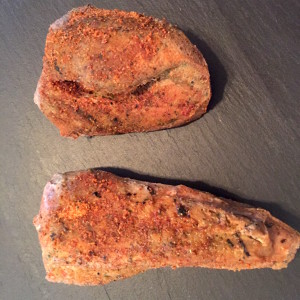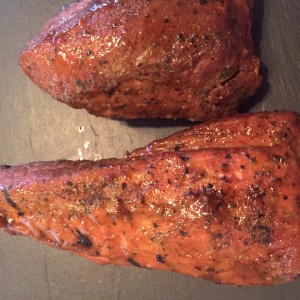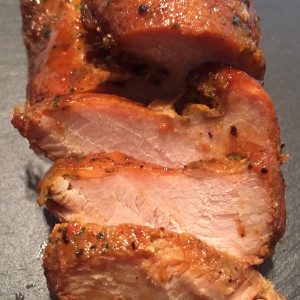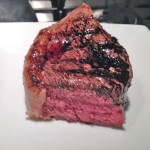Pork tenderloin takes a back seat to pork brisket in taste, texture and versatility. Pork brisket is usually less expensive, though harder to find, but your search is worth the difference your guests will find when on the table.
Another bonus for pork brisket is the extremely low fat content, only 13.5% compared to pork tenderloin at 21%. Better flavor, juicier, and less fat? Too good to be true? Nope, read on!
The native taste of pork brisket is similar to pork loin roast, but if you smoke the brisket as I do, it’s a pleasant blend of pork loin and a sparerib.
Pork brisket is the same muscle as beef brisket, according to Devin Kulla in Pork Marketing at Swift and Company, packagers of the pork brisket I prepared. “The pork brisket, sometimes called the deckle, comes from the picnic. It is the pectoral muscle and is the equivalent to the brisket on a cow,” responded Kulla when I asked him about pork brisket–a new cut for many of us.
Pork brisket lends itself splendidly to sous vide. Like a beef brisket it’s a tough cut, and of course sous vide makes tough cuts, junk cuts, any cut tender if you give it long enough, which you’ll need to do. 24 hours seems to be the sweet spot after some experimenting
Recipe and Procedure
Brine
This is my standard brine for everything except for turkey. It’s a 5% solution, and I use it on chicken breasts and pork. Brine the pork brisket overnight to 24 hours.
Brine (5% solution)
40 ML salt (3 tbsp)
40 ML brown sugar (3 tbsp)
1/2cup (1/4 litre) water
1/2 cup apple juice
1/2tsp garlic powder
2 tbsp molasses
1 tsp liquid smoke
Cold Smoking (optional)
After done with the brine soak and gentle rinsing and patting the brisket dry with a paper towel, cold smoke the brisket for up to two hours, but no more than one hour if the outside temperature exceeds 80 deg. F for food safety purposes. For cold smoking, I highly recommend the Amazen Pellet Smoker that I use for nearly everything to infuse smoke flavor, without cooking the meat, prior to sous vide. Here’s a step by step cold smoking procedure.
Sous Vide
After cold smoking if you take that step (you really should for great flavor), simply add some preferred rub to the brisket, vacuum seal, and sous vide for 24 hours at 135F. The cooking temperature doesn’t make

as much difference as in some meats, however my first try with brisket was at 152F and it was slightly dry. 135F-140F is the best range, yielding a slightly pinkish tint to the pork and leaving it moist and tender. The taste difference between the lower and higher temperatures was not distinguishable.
Glazing
Glazing over a hot fire, preferably a charcoal grill, but a hot (500F or better) gas grill will work, as will a hot cast iron pan or a torch, adds considerable flavor to any pork and achieves the desired Maillard Reaction.
Using the natural juices rendered in your cooking bag from the sous vide, here’s a tasty glaze that really makes this brisket pop.

50% natural juices
50% blend of honey, maple syrup, and a thick, rich BBQ sauce
Blend the ingredients with an immersion blender, or by hand, until the glaze is at a consistency where you can brush it on the pork.
Glazing is best accomplishes by layering. Brush one side of the brisket with the glaze, put the heat to it for about 45 seconds while brushing the other side of the meat facing you. Repeat this process about 5 times per side until the glaze is shiny and you see a nice char starting to form.
Slice in 1/4″ slices and serve. I like to add some good dijon mustard and wasabi sauce for dipping.



Leave a Reply